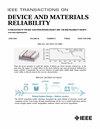热载荷下模压下填充倒装封装界面角起裂新准则的应用
IF 2.3
3区 工程技术
Q2 ENGINEERING, ELECTRICAL & ELECTRONIC
IEEE Transactions on Device and Materials Reliability
Pub Date : 2025-07-07
DOI:10.1109/TDMR.2025.3586592
引用次数: 0
摘要
长期以来,多材料界面的角点或边缘开裂一直是工程部件和结构可靠性的关键问题。特别是,为了提高可靠性和集成电路(IC)产品的成品率,对先进电子封装中由于界面裂纹和分层而导致的失效风险进行准确预测是非常重要的。本文提出了一种将奇异点渐近应力解与最大平均切向应力(MATS)和最大切向应变(MTSN)准则相结合的新方法来预测裂纹起裂角和临界断裂条件。本文首先对文献中报道的硅/玻璃阳极键受偏三点弯曲的实验结果进行了验证,证明了其准确性和可靠性。此外,更重要的是,将验证的准则应用于分析典型模压下填充倒装芯片(MUF FC)封装在加热和冷却载荷下的开裂行为。预测的裂纹起裂角与有限元分析得到的断裂力学参数的解析结果接近。本研究将可靠性评估向前推进,为MUF FC封装结构界面角裂纹起裂预测建立了一个实用可靠的框架,也有望应用于其他先进的电子封装。本文章由计算机程序翻译,如有差异,请以英文原文为准。
Application of New Criteria for Predicting Crack Initiation From the Interface Corner in the Molded Underfill Flip-Chip Package Under Thermal Load
Cracking at corner points or edges of multi-material interfaces has long been a critical reliability concern for engineered components and structures. In particular, accurate prediction of failure risks due to interface crack and delamination in advanced electronic packages is highly demanded for improvement of the reliability and the integrated circuit (IC) product yield. This study proposes a new approach, which combines the asymptotic stress solution at the singularity with the maximum average tangential stress (MATS) and maximum tangential strain (MTSN) criteria, to predict the crack initiation angle and critical fracture conditions. The proposed approach is first validated against the experimental results for silicon/glass anode bonds subjected to biased three-point bending as reported in the literature, demonstrating its accuracy and reliability. Further, and more importantly, the validated criteria are applied to analyze the cracking behavior of a typical molded underfill flip-chip (MUF FC) package under both heating and cooling loads. The predicted crack initiation angles are close to the analytical results derived from the fracture mechanics parameters obtained by finite element analysis. The present study has moved the reliability assessment forward to establish a practical and reliable framework for predicting the crack initiation at the interface corner of the MUF FC package structure, which is also highly anticipated to be used in other advanced electronic packages.
求助全文
通过发布文献求助,成功后即可免费获取论文全文。
去求助
来源期刊

IEEE Transactions on Device and Materials Reliability
工程技术-工程:电子与电气
CiteScore
4.80
自引率
5.00%
发文量
71
审稿时长
6-12 weeks
期刊介绍:
The scope of the publication includes, but is not limited to Reliability of: Devices, Materials, Processes, Interfaces, Integrated Microsystems (including MEMS & Sensors), Transistors, Technology (CMOS, BiCMOS, etc.), Integrated Circuits (IC, SSI, MSI, LSI, ULSI, ELSI, etc.), Thin Film Transistor Applications. The measurement and understanding of the reliability of such entities at each phase, from the concept stage through research and development and into manufacturing scale-up, provides the overall database on the reliability of the devices, materials, processes, package and other necessities for the successful introduction of a product to market. This reliability database is the foundation for a quality product, which meets customer expectation. A product so developed has high reliability. High quality will be achieved because product weaknesses will have been found (root cause analysis) and designed out of the final product. This process of ever increasing reliability and quality will result in a superior product. In the end, reliability and quality are not one thing; but in a sense everything, which can be or has to be done to guarantee that the product successfully performs in the field under customer conditions. Our goal is to capture these advances. An additional objective is to focus cross fertilized communication in the state of the art of reliability of electronic materials and devices and provide fundamental understanding of basic phenomena that affect reliability. In addition, the publication is a forum for interdisciplinary studies on reliability. An overall goal is to provide leading edge/state of the art information, which is critically relevant to the creation of reliable products.
 求助内容:
求助内容: 应助结果提醒方式:
应助结果提醒方式:


